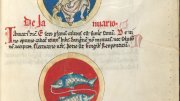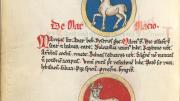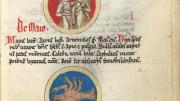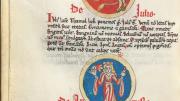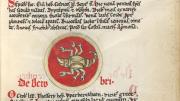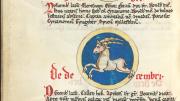In the middle ages, as now, following rules could give comfort in the chaos of life. Shown here are all six pages of an illuminated manuscript offering medical and dietary advice month by month for a year, mapped by the signs of the zodiac. It begins with an embellished headline, “Kalends Ianuarii,” and a drawing of Aquarius. Throughout, the names of the months are given in Hebrew and Greek, as well as Latin. The core of the manuscript consists of a series of Latin hexameters embedded within a scattering of dicta on how to lead a healthy life. Thus:
- January: Escas per Janum calidas es sumere sanum. (In January, it’s healthiest to eat warm food.)
- February: Avoid frost, and let blood flow from the thumb.
- March: Eat roasted meat and take baths.
- April: Fill your belly with fluids and drain the foot of blood.
- May: These seven things are useful for good spices.
- June: Eat lettuce leaves with apples, and drink from fountains.
- July: Do not slash the veins, moreover avoid them altogether.
- August: Avoid warm food, this month you have no need of it.
- September: Blood-letting is good, and then you ought to eat spices.
- October: Drink cattle or curdled sheep’s milk.
- November: At this time spices with cinnamon are useful to man.
- December: In the month of December, warm things are good for your limbs.
The manuscript is explicated by Jeffrey F. Hamburger, Francke professor of German art and culture, in an essay, “Rules to Live By: A Late Thirteenth-Century De Regimine mensium,” published last July in the Harvard Library Bulletin, volume 21, numbers 1-2. The manual is complete, but it is only a fragment of a longer manuscript on a topic and by an author unknown, created one doesn’t know precisely where or when. Hamburger writes that illustrated medical manuscripts “would appear to remain very rare” and guesses that the book may have belonged “to a wealthy patient or perhaps to a monastic library.”
The double issue of the Bulletin, edited by Hamburger and entitled “Piecing Together the Picture: Fragments of German and Netherlandish Manuscripts in Houghton Library,” came about in this way. In March 2010, a “group of colleagues,” most from Germany, got together at the Radcliffe Institute for a colloquium on German manuscript illumination. The speakers visited Houghton Library, where librarians had spread out for examination virtually all of the German illuminated manuscripts the library has. These treasures knocked the socks off the assembled academics, who, Hamburger tells us, decided “on the spot” that each would choose one of the fragments before them as the subject of a short essay. Hence this special issue, the serendipitous outcome of a gathering of stimulated scholars.
